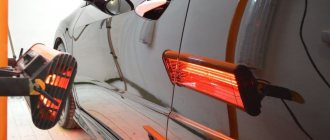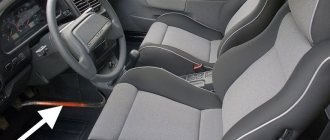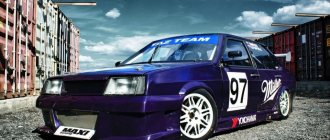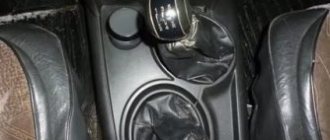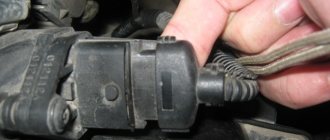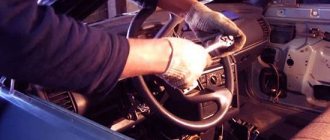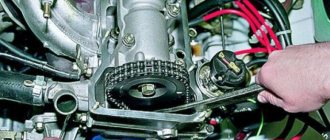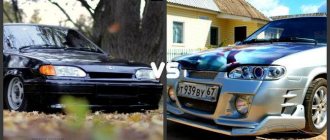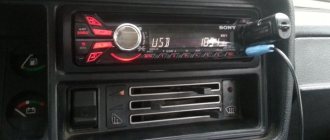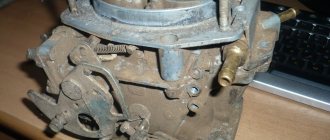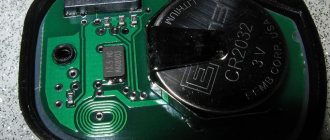What to do in case of skidding?
The most common cases are when the rear axle of a front-wheel drive car develops skidding. Here the front of the car continues to move in the same direction. At the same time, the rear wheels stop following. Thus, rotational movements occur, which intensify under the influence of centrifugal force.
You can correct the situation if you determine the reason for its development:
- sliding caused by too sharp a start, acceleration requires a reduction in speed - you need to stop pressing the gas;
- In situations caused by sudden braking, you need to stop pressing the brake.
These actions are aimed at reducing the dangerous effects of lateral forces.
To optimize the situation it is important:
- turn the steering wheel in the direction where the car is skidding; then the car will begin to turn in the opposite direction and will take its original position;
- you need to control the steering wheel evenly, ensuring a gradual return of the wheels to the desired position;
- To prevent a rear-wheel drive vehicle from skidding in the other direction, it is recommended to turn the steering wheel so that the angle is proportional to the amount of the current slip.
During operation, movements should be smooth so that the situation does not worsen to the point of developing a serious or rhythmic skid.
Front-wheel drive
On a front-wheel drive car, the main thing is not to let go of the gas.
On a front-wheel drive car, the main thing is not to let go of the gas.
This type of drive is the most popular. Skidding on a front-wheel drive car occurs for the same reason as on a rear-wheel drive car. If you jerked the steering wheel sharply or braked - welcome to the ditch!
The front wheels pull and turn the car, so the main rule is to never let off the gas. Even if the stern “went for a walk” somewhere to the side, it’s not scary. The front drives will take you both on the straight and in the turn. And again, an important rule - do not touch the brake, it will turn around!
At the exit of the turn, if you have too much throttle, the front axle may begin to drift to the outer part of the turn. There is no need to be afraid: there is snow on the edge of the road, and the tires will catch on it, stopping the slide. But it’s better not to let it come to this, but to lift your foot off the gas pedal. In this way, the driver loads the front of the car and increases downforce and, as a result, grip through “engine braking”. This allows you to stabilize the car and reduces the likelihood of the front axle drifting. Remember: the less slipping, the more stable the car and the safer the movement.
Skidding of rear-wheel drive cars
It is not difficult to understand the reasons for the development of the situation. The problem is to learn how to get out of it, overcoming the fear that sometimes appears in the initial stages. The most difficult thing is to skid the rear axle of a rear-wheel drive car.
You can’t miss the moment here, you need to act immediately:
- When a skid develops, the rear of the car is pulled to the side, and the steering wheel turns in the same direction.
- Depending on the reason for the formation of such a situation, either the gas pedal or the brake is released.
- Next, you need to work the steering wheel until the rear of the car returns to its original position.
- At this point, the steering wheel should return to the position required for subsequent movement.
It is extremely undesirable, and even dangerous, during this period:
- use the handbrake;
- try to change gear;
- press on the brake.
All this leads to increased skidding and the development of a serious emergency situation.
Skidding of front-wheel drive cars
When a front-wheel drive car skids when turning, it is worth considering the design feature.
Here the front wheels should pull the car, so you need to press on the gas, promoting an increase in speed. In this case, the driver must ensure that the front wheels do not spin.
Steps requiring attention:
- Without stopping to press on the gas, it is necessary to align the wheels in the front.
- Timely action when a car skids is extremely important. Therefore, a moment before the stern is returned to its original position, the rudder turns in the opposite direction.
- The steering wheel returns to its original position before the rear end stabilizes.
When the danger has passed, the speed decreases and normal movement continues.
Four-wheel drive
A four-wheel drive vehicle is the most stable on ice. It will cling to the surface with all its wheels until the last moment, but... |
...an all-wheel drive vehicle skidding occurs abruptly, and you need to be prepared for this. |
All-wheel drive vehicles have many design options that affect handling to varying degrees. For example, on cars with a plug-in front axle (such as Volkswagen Amarok, Toyota Fortuner, Isuzu D-Max), you can use techniques that are relevant for rear-wheel drive cars. Cars with viscous couplings (Toyota RAV4, Honda CR-V, Ford Kuga) allow you to stop the rear wheels with a parking brake system and use some techniques for driving a front-wheel drive car. There are also general control techniques: forget about the brake in a slippery turn, turn the steering wheel in the direction of the skid and hold the gas. Release the pedal and the car will immediately slide out of the turn with all four wheels.
The all-wheel drive vehicle clings to the road to the last. It is the most stable of all three drive types. But the slip occurs abruptly, and this must be taken into account. In any case, you need to operate the gas smoothly. With sufficient traction, the car will remain controllable.
***
Counter-accident driving techniques are used to correct a mistake that the driver has already made. Don’t bring it to this point, predict the situation in advance. If the winter road is poorly cleared/lit/visible or there is ice on it, and there is a sharp turn ahead, slow down in advance and be careful. Good luck on the roads!
Photo: manufacturing companies
How to cope with skidding - instructions "Behind the Wheel"
Subtleties of output for all-wheel drive vehicles
Operating all-wheel drive models requires skills and knowledge of what to do when the car skids, since these situations are the most dangerous. Often the driver can only wait until the car stops. The type of all-wheel drive matters here. Also, most of it can be fed to a specific axis.
To prevent loss of control of the car, you should follow the recommendations:
- If this does happen, you should turn the steering wheel directly in the direction the car is skidding. The later the reaction, the faster you need to turn the steering wheel to stabilize the vehicle.
- Proper seating and the absence of sudden maneuvers while driving help prevent unforeseen situations.
- It is important not to release the gas, and pressing the brake pedal will make it impossible to maneuver further, which will aggravate the situation.
A situation such as a car skidding on the road is quite dangerous. But even worse is to succumb to fear. This is where mental toughness, experience and preparation go a long way. You can improve your skills by artificially creating drifts on areas or sections of the roadway where there are no other cars or pedestrians.
Why does loss of control occur?
Loss of traction between tires and road surface does not just happen. There are always reasons for a car skidding, which are represented by mistakes, making wrong decisions while driving.
- Skidding when pressing the gas or braking is common. The solution is to stop pressing the gas or brake pedal and continue maneuvering.
- Loss of control when entering a turn occurs as a result of:
- sharp turn of the steering wheel;
- cornering at high speed;
- sharply pressing or releasing the gas pedal when performing a maneuver;
- a strong, sudden application of the brake.
In winter, when the road is slippery, any sudden maneuver or movement of the driver leads to loss of control.
The following road sections require special attention:
- turns in places with serious unevenness;
- steep descents;
- zones of forced movement on a slope.
Correct sitting, accompanied by a tight fit of your back to the seat, allows you to sense a loss of control in time and take measures to restore safety. This approach will allow you to learn how to identify drifts at the initial stage and quickly get out of them.
Rear drive
This is a classic. The driving wheels are at the rear, they push the car forward, and the front wheels turn. That is why, in a turn, as soon as the driver turns the steering wheel to go into a turn and sharply presses the gas, the drive wheels slip and the rear axle tries to overtake the front. skidding occurs
. You need to fight him before the car turns 180 degrees. To do this, turn the steering wheel in the direction of the skid and smoothly remove the traction, that is, release the gas pedal.
To counter a skid on rear-wheel drive, you need to release the gas pedal and turn the steering wheel in the direction of the skid.
To counter a skid on rear-wheel drive, you need to release the gas pedal and turn the steering wheel in the direction of the skid.
And under no circumstances do we press the brakes! This will only make the situation worse.
The main thing here is not to hesitate, to work ahead of the wheel. Otherwise, the car will not stabilize after a skid, but will go into another, then into a third. It's called rhythmic drift
. Each time its amplitude increases, and it becomes more and more difficult to catch the car. Especially, as you might guess, in winter. As a rule, this ends tragically - in a ditch or oncoming traffic.
This is what a rhythmic drift looks like in theory.
And this is how it is in practice.
To reduce the risk of skidding on a winter road, you must adhere to the speed limit, brake before turning and select the gear in which you want to drive this turn ahead of time. If the road is slippery, it is better to choose a lower gear and switch the automatic transmission to manual mode and select, say, third or second gear.
To avoid feeling like a cow on ice, you can use the outside of the turn. There is usually a lot of snow there, and there is ice in the middle and on the inside of the turn. The tires cling to the snow, thus, as athletes say, a “grip” appears. This way you can make the turn safer and faster.
To avoid feeling like a cow on ice, you can use the outside of the turn. There is usually a lot of snow there, and there is ice in the middle and on the inside of the turn. The tires cling to the snow, thus, as athletes say, a “grip” appears. This way you can make the turn safer and faster.
You need to pedal smoothly, but if you need to quickly slow down before turning, apply the brakes vigorously and boldly. ABS system
will prevent the wheels from locking.
The anti-lock braking system does not shorten the braking distance, as is often erroneously claimed, but it allows you to maintain control over the car. This means there is a chance, by turning the steering wheel, to get away from an obstacle or an oncoming car. The Brake Assist system
, can reduce braking distances . Electronics increases the pressure in the brake system without waiting for the driver to fully press the pedal. This allows you to start braking a little earlier, and with the highest possible intensity.
Many modern cars, regardless of the type of drive, also have an ESP stability control system.
. It prevents the car from skidding or drifting. Of course, the system is useful and will help in a difficult situation, but, alas, it is not a panacea for all ills. If the driver goes too fast when entering a turn, the electronics will first brake the drive wheels and then reduce the fuel supply, making it impossible to get the car out of a skid using gas. The driver turns into a spectator.
Most modern cars have a function to disable the ESP system. Either with a button or through the on-board computer menu. As a rule, it is not the stabilization system itself that is turned off, but the ASR traction control system.
. The latter works in conjunction with ESP, ABS and other electronic assistants. It is necessary to disable ASR if the car is stuck in a snowdrift or cannot drive up a slippery slope. Then the electronics will not slow down the drive wheels, and it will be easier to overcome the climb.
